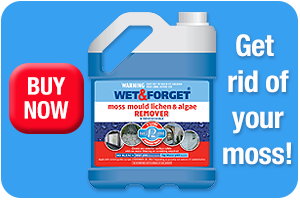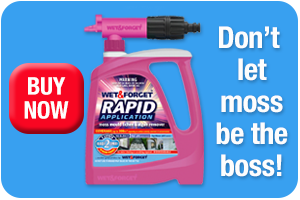Moss Should be Considered as a Wonder of the World

Well it sure is when you see moss carpeting a forest floor, in a rockery, riverbank, in gardens or on rotten logs. However, this often loses its appeal when it’s growing on the South side of your house or on the slippery paths adjoining it so it's definitely Moss Eradication time again!
But what is moss?
Mosses are a group of fuzzy plants that belong to the division Bryophyta. There are around 12 000 species of moss. They are hardy and have been found just about everywhere, except in salt water.
Moss can grow both on the trees and on the ground, but it can be also found on the rocks, under the water, on the clay. Moss is a relatively uncomplicated plant, lacking the leaves, stems, roots and buds. It has no roots so it uses tiny threads to anchor itself to the stones, trees or ground where it grows.
- Mosses are indicators of pollution as they can grow only in clean environments.
- Mosses are able to absorb huge amount of water and prevent erosion of soil as a result of water runoff.
- Mosses are usually bright green in colour.
But where is its dream home?
If you asked moss to describe its dream home, it would very likely reply: Wherever it is cool, moist and dark - like shady ground, rock ledges or tree trunks. In our southern hemisphere, the sun shines from the north which means the south side of houses and tree trunks are typically the shadiest. In order for moss to grow, it requires a damp environment or water, humidity, mild sunlight and a soil pH below 6.5.
Mosses are useful though
They are the first to establish themselves on rocky land, breaking down rock and soil, creating a more hospitable environment for 'vascular' plants to move into the neighbourhood.
The moss’s ability to absorb moisture also allows it to act as a sort of sponge, soaking up rainfall and helping prevent erosion of the landscapes where it lives.
As a decomposer, in a forest, moss carpets the floor and fallen organic matter such as rotting logs. This helps to decompose the logs and recycle the nutrients.
Bet You Didn't Know These Facts About Moss?
- During World War II, Sphagnum moss was used to dress soldiers’ wounds and prevent blood loss. These bandages absorbed well & soothed the infection with their anti-bacterial properties.
- In Mexico, moss is used as a Christmas decoration.
- Reindeer consume mosses because they contain a chemical which warms the blood of animal.
- In the past, people used dried mosses for insulation of houses as many mosses can absorb liquids up to 20 times their weight.
- Live mosses were used to insulate boots in cold climates.
- Moss was a popular toilet paper in times gone by.
How to Remove Moss by Using Wet & Forget
Wet and Forget is an extremely safe product to use. Once applied and the product is dry, the Wet and Forget molecules will adhere to the sprayed
surface, thus preventing any run off contamination. Because the surface to be cleaned is only to be wet with the product to a point prior to run off, there is absolutely no contamination of the environment.
Some Helpful Safety Hints When applying Wet and Forget or Rapid Application onto any exterior surface. Remember to
- Wear protective gloves/clothing/eye/face protection.
- Spray onto a dry surface/non windy day
- Spray when children are not around
- Allow a 4-5 hour drying
- Wet & Forget is not systemic and will not harm plants but do protect them from overspray as it can slightly scorch the foliage.
- Wet & Forget is absorbed into the surface of substrate once applied.
- Wet & Forget is non acidic, non caustic and contains no bleach.
Why is a Wet & Forget Good to use?
Wet and Forget has been used commercially for 35 years+ with its birth stemming from a need to create a safe product that would remove biological growth such as moss, lichen, algae and black mould from all exterior surfaces with little or no impact on the environment or the human body.
The main benefits with Wet & Forget are that the product is non-caustic, non-acidic and contains no bleach. In fact it has a pH of 7.6 which is very close to that of tap water. The product is not systemic or hormone based so it is very safe to use commercially. It will not damage any exterior surface, whether it be paint, brickwork, concrete, aluminium, fibreglass, vinyl or aluminium weatherboards, outdoor furniture, pavers, canvas or synthetic awnings.
All other cleaning methods require one of the following.
- water blasting
- scrubbing
- the use of aggressive chemicals, or all of the above. These all involve aggressive methods and they all potentially damage the surfaces being cleaned. Wet & Forget helps prevent the damage caused by the harsh scouring of scrubbing and waterblasting. An added bonus is that some of the ingredient remains active if the surface is porous to prevent premature recontamination.
How to Remove Moss by Using Rapid Application
- No mixing! No measuring! No mess!
- Choose a cool, dry windless day with no rain expected - to apply Rapid Application®
- Saturate the dry surface you are cleaning with the Rapid Application®
- NO rain for the first 5 hours - Then, just watch it come cleaner - bit by bit
- Only one application! (except in extreme cases of heavy contamination
- Total saturation of the surface with this product is essential in order to obtain a good kill of the fungi, algae, lichen, moss & algae which infests these surfaces.
- Make sure the surface is dry in order to get the best penetration of the growth with the least amount of evaporation.
- If the surface is particularly bad, another application approximately one month from the first application and then allow the surface to weather naturally.
- Nature will take its course. The growth decomposes while the rain gently removes them from the surface over time.
- After 1st application use as a maintenance tool. Only re-apply at the first sign of regrowth.









